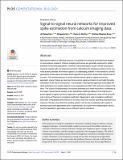| dc.contributor.author | Sebastian, Jilt | |
| dc.contributor.author | Sur, Mriganka | |
| dc.contributor.author | Murthy, Hema A. | |
| dc.contributor.author | Magimai-Doss, Mathew | |
| dc.date.accessioned | 2022-06-13T15:00:41Z | |
| dc.date.available | 2021-10-27T19:54:00Z | |
| dc.date.available | 2022-06-13T15:00:41Z | |
| dc.date.issued | 2021-03 | |
| dc.date.submitted | 2020-04 | |
| dc.identifier.issn | 1553-7358 | |
| dc.identifier.uri | https://hdl.handle.net/1721.1/133651.2 | |
| dc.description.abstract | <jats:p>Spiking information of individual neurons is essential for functional and behavioral analysis in neuroscience research. Calcium imaging techniques are generally employed to obtain activities of neuronal populations. However, these techniques result in slowly-varying fluorescence signals with low temporal resolution. Estimating the temporal positions of the neuronal action potentials from these signals is a challenging problem. In the literature, several generative model-based and data-driven algorithms have been studied with varied levels of success. This article proposes a neural network-based signal-to-signal conversion approach, where it takes as input raw-fluorescence signal and learns to estimate the spike information in an end-to-end fashion. Theoretically, the proposed approach formulates the spike estimation as a single channel source separation problem with unknown mixing conditions. The source corresponding to the action potentials at a lower resolution is estimated at the output. Experimental studies on the spikefinder challenge dataset show that the proposed signal-to-signal conversion approach significantly outperforms state-of-the-art-methods in terms of Pearson’s correlation coefficient, Spearman’s rank correlation coefficient and yields comparable performance for the area under the receiver operating characteristics measure. We also show that the resulting system: (a) has low complexity with respect to existing supervised approaches and is reproducible; (b) is layer-wise interpretable, and (c) has the capability to generalize across different calcium indicators.</jats:p> | en_US |
| dc.language.iso | en | |
| dc.publisher | Public Library of Science (PLoS) | en_US |
| dc.relation.isversionof | http://dx.doi.org/10.1371/journal.pcbi.1007921 | en_US |
| dc.rights | Creative Commons Attribution 4.0 International license | en_US |
| dc.rights.uri | https://creativecommons.org/licenses/by/4.0/ | en_US |
| dc.source | PLoS | en_US |
| dc.title | Signal-to-signal neural networks for improved spike estimation from calcium imaging data | en_US |
| dc.type | Article | en_US |
| dc.contributor.department | Massachusetts Institute of Technology. Department of Brain and Cognitive Sciences | |
| dc.relation.journal | PLoS Computational Biology | en_US |
| dc.eprint.version | Final published version | en_US |
| dc.type.uri | http://purl.org/eprint/type/JournalArticle | en_US |
| eprint.status | http://purl.org/eprint/status/PeerReviewed | en_US |
| dc.date.updated | 2021-03-18T13:56:08Z | |
| dspace.orderedauthors | Sebastian, J; Sur, M; Murthy, HA; Magimai-Doss, M | en_US |
| dspace.date.submission | 2021-03-18T13:56:12Z | |
| mit.journal.volume | 17 | en_US |
| mit.journal.issue | 3 | en_US |
| mit.license | PUBLISHER_CC | |
| mit.metadata.status | Authority Work Needed | en_US |
